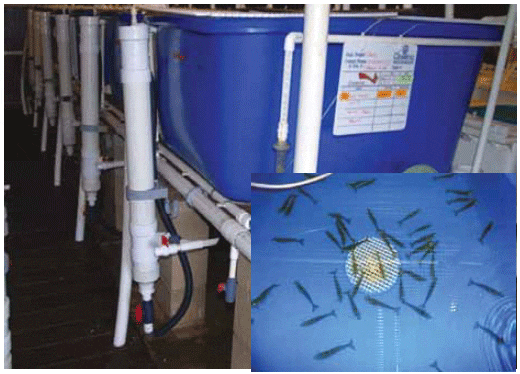
With the rapid global expansion and
increased production of aquaculture,
increases in aquatic feed production are
challenged by the availability of traditional
ingredients such as fishmeal and fish oil,
and environmental sustainability. Therefore,
alternative ingredients are being
explored to replace traditional ingredients
to meet the demands of the fast-growing
feed industry. For example, utilization of by-products from different industries in
aquatic feeds is becoming attractive.
Beyond the nutritional composition
of an ingredient and its effect on palatability, digestibility is often a concern in
aquatic feeds. In a study funded through
a grant from the U.S. Department of
Agriculture Agricultural Research Service and a cooperative agreement with the
University of Alaska Fairbanks, the authors
determined the digestibility of six
fisheries by-products in shrimp feed.
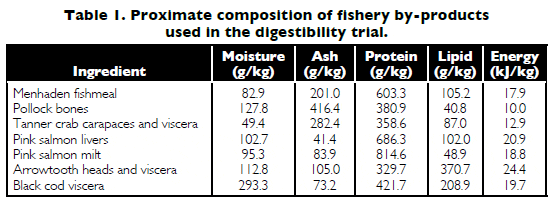
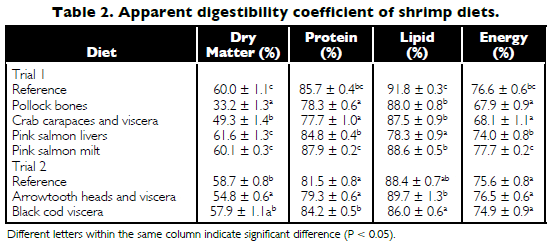
Digestibility Study
Alaska has the largest number of fisheries
in any United States state. Its annual
fisheries production totals 1.84 mmt, and
processing generates significant amounts
of by-products. Previous research by the
authors demonstrated that some fisheries
by-products contained significant
amounts of nutrients and exhibited a
stimulating effect on shrimp fed plant
protein-based diets.
For this digestibility study, six Alaskan
fisheries by-products from processing
plants in Kodiak, Alaska, were supplied
by the University of Alaskas Fishery
Industrial Technology Center (Table 1).
A reference diet containing 40.0% protein
and 9.0% lipid was formulated with
34.2% menhaden fishmeal, 32.7% whole
wheat, 12.5% soybean meal, 6.0% vital
wheat gluten, 5.0% brewers yeast, 2.5%
squid meal, 2.0% soy lecithin, 1.6% menhaden
oil, 1.0% chromic oxide and 4.5%
other ingredients, including vitamins and
minerals. Chromic oxide was used as a
marker to estimate digestibility.
The test diets were formulated by
replacing the reference diet with 30% byproduct.
The diets were milled to a pellet
size of 2.4 x 4 mm.
The digestibility trial was conducted in
an indoor system with flow-through water
and a photoperiod with 12 hours light and
12 hours dark. Four replications were used
for each dietary treatment. In trial 1, 6-g
shrimp were stocked at 100/tank, and in
trial 2, 14-g shrimp with 75 shrimp/tank
were stocked. Shrimp were fed 10% of
body weight for two hours before fecal
samples were collected. Water quality was
monitored during the trials, with temperature
at 26.5 0.2 C, salinity at 31.0 0.3
ppt, dissolved oxygen at 6.0 0.3 mg/L,
pH at 7.8 0.1 and total ammonia nitrogen
below 0.08 mg/L.
Nutrient Composition
Proximate composition analysis of the
tested by-products showed that the
salmon livers and milt meal had higher
protein levels than menhaden fishmeal
(Table 1). The rest of the by-products
had lower protein levels than the fishmeal,
but still contained significant levels
of crude protein ranging from 35 to 42%.
The crude protein level for the black
cod viscera could be increased from 42 to
50% if moisture could be removed from
the product. Some by-products, such as
the arrowtooth heads and viscera, and the cod viscera, were found to be rich lipid
sources. The by-products from crab carapaces
and viscera, and pollock bones had
very high ash content. All the by-products
except pollock bones and crab carapaces/
viscera contained higher gross
energy than the fishmeal.
Apparent Digestibility
The apparent digestibility coefficients
(ADCs) of the test diets showed that the
diets containing salmon livers or milt had
the same digestibility as the reference diet,
except that the lipid ADC was lower than
for the reference diet (Table 2). The
ADCs of test diets containing pollock
bones or the crab carapaces and viscera
were significantly lower than the ADC for
the reference diet. The ADCs of nutrients
for the diets with arrowtooth heads and
viscera or black cod viscera were similar to
the ADC of the reference diet.
Among all by-products, the ADC for
crude protein was the highest for the
salmon milt, followed by those for the
black cod viscera and the arrowtooth
heads and viscera, which had values similar
to that for the salmon liver (P > 0.05)
(Figure 1). The pollock bone and crab
carapace and viscera treatments exhibited
significantly lower ADC values for crude
protein than the other by-products did.
The ADC values for crude lipid were
significantly lower for the pollock bones
and salmon livers than the other by-products (Figure 2). Although not presented,
the ADC values for gross energy were
lower for the pollock bone and crab carapace/
viscera treatments than those for the
remaining by-products used in the test.
Apparent Digestibility Coefficents (%)
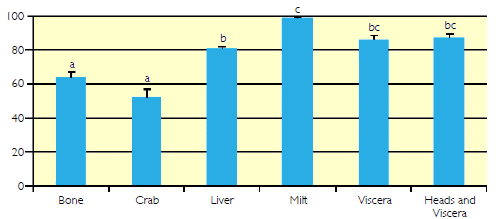
Perspectives
The study demonstrated that byproducts
from salmon livers and milt,
black cod viscera, and arrowtooth heads
and viscera were easily digested by Pacific
white shrimp. These by-products are also
rich in protein and/or lipids.
Previous studies have shown that supplementation
of these by-products in
shrimp feed stimulated feeding in shrimp
fed a plant protein-based diet. Therefore,
based on evaluation of the proximate
compositions of the by-products and
their effects on palatability and digestibility
in shrimp, the by-products can be
considered good candidates as ingredients
or additives for shrimp feed. Investigation
of their effects on the growth performance
of shrimp will be needed to further support
this conclusion.
The low digestibility of pollock bones
and crab carapaces and viscera could be
due to the high level of ash in these byproducts.
The authors previous studies
also showed that these by-products had
no stimulating effect on shrimp feeding.
Therefore, under current conditions, the
by-products are not good candidates for
ingredients in shrimp feed.
Apparent Digestibility Coefficents (%)
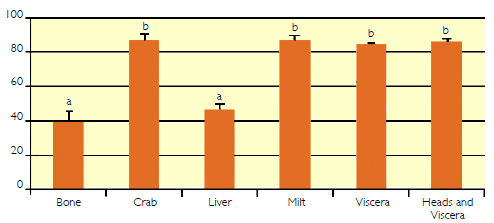
July 2012



